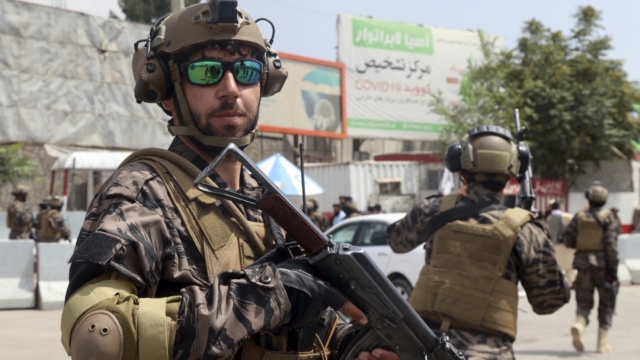New Delhi: Arms and equipment worth millions of dollars that were left in and around Kabul by the retreating forces of the United States are now finding their way to the Pakistani military establishment, The Sunday Guardian has reliably learnt from sources who are a part of these transactions.
Sources told The Sunday Guardian that while the Taliban leadership, which has been ruling Kabul since 15 August, has kept a part of the weapons, mostly guns and explosive devices with it, it has handed over or is handing over by terming it as a business transaction—the majority of these to the Pakistan military.
Some of these weapons, a development which has not come as a surprise, have been distributed to other jihadi “tanzeems” (groups) by the Taliban. Whether these groups also include the Lashkar-e-Tayyaba (LeT) and Jaish-e-Mohammed (JeM) is not clear as of now, but the likelihood of them getting these weapons has been termed as “highly likely” by relevant organisations tasked with keeping an eye on these groups.
Sources said that the transfer of weapons to the Pakistan military was amongst the most prominent topics that were discussed when Pakistan’s intelligence agency ISI’s chief Faiz Hameed flew to Kabul in the first week of September.
While sources have told The Sunday Guardian that the Taliban is getting “good money” for transferring the weapons to the Pakistan military
Independent sources in the Af-Pak region confirmed that some of the US made weapons were now being carried by Pakistan Army personnel, especially those who are posted in the restive Baloch region where a separation movement is going on for decades.
As per US Department of Defense (DoD) data, in the period between 2003 and 2016, the Afghan National Police and the Afghan National Army got 6 lakh guns, 1.70 lakh communication equipment, 76,000 vehicles, 29,000 explosive disposal equipment, 16,000 intelligence, surveillance equipment and 208 aircraft. The communication equipment included 2,000 ultra and super high frequency radio sets.
Of the 6 lakh guns that went into Kabul, include 3.58 lakh M16, M4 carbines, AK47 and Dragunov sniper rifles, 1.25 lakh pistols, 65,000 machine guns that include M249 and M240, 25,000 grenade launchers and almost 10,000 rocket launchers. Of the 76,000 vehicles, 189 were armed personnel carriers, 928 mine resistance vehicles and 9,000 medium tactical vehicles.
The personnel of “The Badri 313 Battalion”, a special commando-style unit of the Taliban, are now exclusively using these weapons left behind by the US. The Taliban now also has access to 16,000 night vision devices, 120 radio monitoring systems, 22 ground based surveillance systems, 8 unmanned air systems that were sold by one of Boeing’s subsidiaries, Insitu and 6 surveillance balloons.
As per the data compiled by Stockholm International Peace Research Institute (SIPRI), delivery of weapons from the US to Afghanistan from 2001 included an estimated 21,924 armoured vehicles (e.g. HMMWV-UA, ASV-150/M-1117), 66 MD-530F armed light helicopters, 34 Cessna-208B armed light transport aircraft, and 53 UH-60A transport helicopters. The US also delivered 65 ScanEagle (unarmed) unmanned aerial vehicles and an estimated 250 Paveway guided bombs.
SIPRI further found that Russia was the second largest supplier of major arms to the Afghan armed forces in the period, accounting for 14% of imports, by volume. All of these deliveries took place between 2002 and 2014.
“Deliveries from Russia mainly consisted of 90 second-hand and newly produced Mi-8MTV and Mi-17 transport helicopters between 2002 and 2014. Early deliveries (2002-2005) were in the form of aid, but most of the transport helicopters were bought via and financed by the USA in 2009-2014, and 10, which were delivered in 2010, were financed by the United Arab Emirates,” SIPRI found.
In its recent report (3 September) on the presence of arms and weapons in Afghanistan, SIPRI noted, “Some of the major arms listed were subsequently lost or scrapped and others—mainly aircraft—were apparently used by Afghan forces in August 2021 to flee Afghanistan. However, a substantial number of the arms sent to bolster the Afghan armed forces have been captured by the Taliban. It is unclear how many of these are or can be made operational—many of the aircraft will need specialized maintenance and spare parts that are probably not easily available to the Taliban. Other, simpler to maintain, major arms such as the light-armoured vehicles can easily be operated for many years. All in all, it seems unlikely that the major arms captured by the Taliban would pose any serious threat to stability among Afghanistan’s neighbours or further afield. However, the large numbers of small arms and light weapons and associated ammunition are potentially of much graver concern.”
The sentiments and concerns have also been echoed by New Delhi-based officials who are tracking the developments. “It is a very worrying development. The sniper guns, the night vision devices that were used by the US Special Forces are now likely to land up with the terror groups via the Pakistan Army. This is likely to embolden the cadre of the terror groups to carry out more daring attacks on Indian installations in the coming days. A few years ago, one of the terrorist groups operating in Kashmir was able to get its hands on a single piece of M4 rifle, which had raised multiple red flags. Imagine if the region is flooded with such guns,” the official said.

